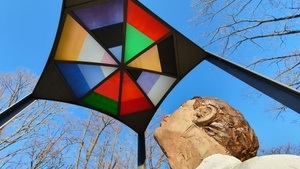KENGO KUMA. ONOMATOPOEIA ARCHITECTURE
In the organizer's words:
The exhibition presents around two dozen models of some of the Japanese star architect's most important buildings. The focus is on the dialog between man and material and the architect's associated recourse to onomatopoeia, or "onomatopoeia".
For his projects, Kuma mainly uses wood, paper and metal - traditional Japanese materials - and applies them in his own contemporary way. In his vision, the surfaces appeal not only to the sense of sight, but also to the sense of smell and touch. The exhibition consists of models of some of his most significant buildings, encouraging visitors to discover the sound of the different materials, including a delicate wooden sculpture designed to express the onomatopoeias "Tsun Tsun" and "Zure Zure". His approach to projects is often tactile, sensory and even sensual. His sensibility also incorporates flow and rhythm, typical elements of music.
Kuma's buildings often have an unexpected lightness or a kind of movement that he attributes to his own musical concept. Avoiding concrete as much as possible, his buildings seem to rest lightly on the ground. Occasionally they even seem ephemeral. Kuma describes himself as a "materialist", in the physical sense of the word. His constant search for new and (sometimes) old building materials reveals to him a wealth of innovative possibilities and materials that are yet to be discovered.
Kengo Kuma (*1954) was born in Yokohama. He has built all over the world, his buildings can be found in Japan, but also throughout Europe, in the United States, China and Australia.
The exhibition is a takeover from the Palazzo Cavalli-Franchetti and was developed on the occasion of the 2023 Architecture Biennale.
This content has been machine translated.Price information:
Free admission up to and including 18 years, with free ELLAHCard* for pupils, students and trainees even up to 25 years. Day ticket for all exhibitions: €13/€6.50 (extra) Happy hour ticket (2 hours before closing time): €7 for all exhibitions Free admission for refugees.











